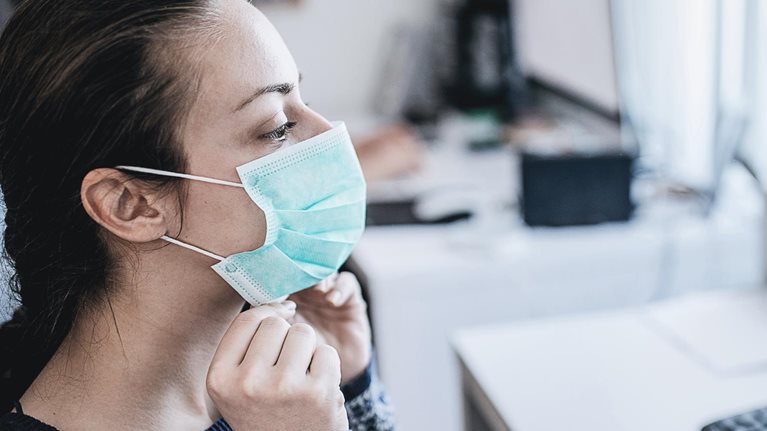As shelter-in-place restrictions lift across the United States, more businesses reopen, and most states require face coverings in public settings,1 results from a new McKinsey survey indicate that US consumers are meeting the next normal with their masks on.2 The use of masks and respirators is nearly universal across the country, with 97 percent of all respondents saying they wear a mask at least once in a typical week.3
Furthermore, mask wearing is a behavior that may endure. A majority of respondents say they expect to wear masks nine months from now,4 and they also report a generally optimistic outlook on COVID-19 (Exhibit 1). Eighty-eight percent believe the country’s infection rate will be lower or the same in nine months, whether or not a vaccine is available, while only 12 percent of respondents believe the COVID-19 situation will get worse. Beyond the near-consensus on mask use and the COVID-19 outlook, the survey results point to a few patterns in how and where people are using masks. First, respondents who are male and younger in age—who are most likely to be back at the workplace, and more likely to have jobs that require face coverings—report higher rates of medical-grade mask use than others. Second, the use of cloth masks is consistently high across geographies, though the use of medical-grade masks is more prevalent in larger cities and urban areas. And third, respondents tend to use their preferred type of mask regardless of their destination.

Respondents at work report higher overall mask use
While mask wearing is reported broadly, the results indicate some notable differences based on age and gender (Exhibit 2). Across age groups, the weekly use of face masks is highest among respondents ages 18 to 64, particularly for medical-grade products. Adults 65 and older, a group that the Centers for Disease Control and Prevention has identified as one at higher risk of developing more serious complications from COVID-19,5 report the least frequent overall mask use. Only 13 percent of these respondents report wearing an N95 respirator at least once a week. By gender, men and women report similar use of both surgical and cloth masks. But 42 percent of men report wearing N95 respirators at least once a week, compared with 26 percent of women.

Younger respondents and male respondents are also more likely than their counterparts to say they have returned to the workplace. At the time of the survey, more than one-third of all respondents report working on-site—and those who have gone back to the workplace report higher use of N95 respirators than those who have not returned (47 percent, versus 25 percent). By age, younger respondents (18- to 64-year-olds) report working on-site more than three times as often as respondents who are 65 and older (Exhibit 3). By gender, 43 percent of male respondents have returned to the workplace, compared with only 30 percent of female respondents.

Respondents report similar differences by age and gender in their reuse of N95 respirators at home (Exhibit 4). Those who continued to work on-site during the pandemic also report higher overall use of N95s, both on the job and for personal use, than others. Of all respondents who report using N95 respirators, younger respondents (ages 18–64) are nearly three times as likely as older respondents to report using the same N95 at work and at home. By gender, 57 percent of male respondents wear the same N95 respirator at home and at work, compared with 35 percent of female respondents.

Use of cloth masks is consistent, while use of medical-grade masks varies between rural and urban settings and by region
At the time of publication, 72 percent of US states had mandated the use of masks in public places (Exhibit 5)—which likely explains why the rate of wearing cloth masks is consistently high regardless of respondents’ geographic location (Exhibit 6).6


For N95 respirators and surgical masks, there are notable differences in use based on the setting. Respondents in larger cities, where residents are in closer proximity, are more likely than those in rural areas, the suburbs, and smaller cities to report the use of medical-grade masks, especially N95 respirators. When comparing the use of medical-grade masks by region, respondents in the Midwest report the lowest rates of wearing both surgical masks and N95 respirators, while those in the Northeast report the highest rates of wearing N95 respirators.
Respondents wear their preferred type of mask wherever they go
Finally, respondents report using masks in a variety of public places—and the type of mask used varies little by the destination (Exhibit 7). Whether they are going to a grocery store or pharmacy for essential errands, to an office building, or on public transportation, respondents most often report the use of cloth masks, followed by surgical masks and N95 respirators. For every type of mask, use is the highest in enclosed spaces where people can expect to encounter those from other households (for example, a retail or grocery store) and lower in outdoor settings or gatherings of friends.

Over time, individuals’ commitment may be the biggest variable in the use of masks
While the survey reveals a clear consensus on the use of face coverings at least once a week, lagging usage in several settings suggests that some consumers’ initial concerns about COVID-19 may be beginning to fade. As COVID-19 continues to unfold, many elements will guide public opinion and behavior: for example, government and business policies about face coverings, recommendations from public-health agencies, access to safe and effective face coverings, and the virus’s epidemiological progression. But ultimately, the US public’s personal motivation and commitment to mask wearing will shape how, if at all, the use of face masks evolves in the months ahead.

